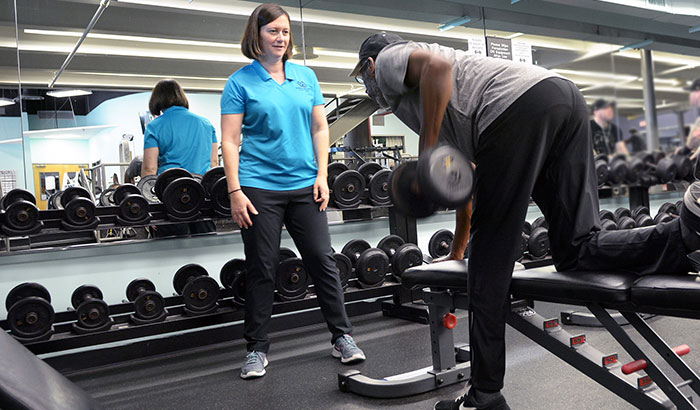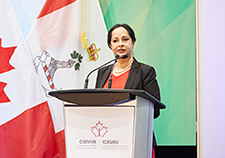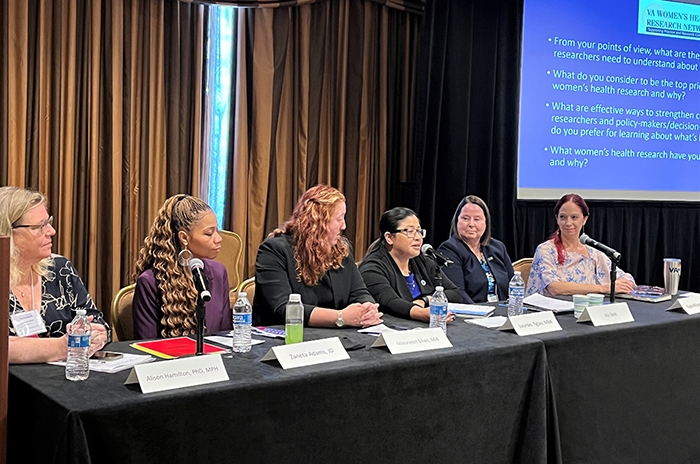Office of Research & Development |
 |


Dr. Katherine Hall helps a Vet with his workout at the Durham VA Medical Center. (Photo by Linnie Skidmore)
April 25, 2018
By Mike Richman
VA Research Communications
"When I spoke with Veterans, they stated this is something they wanted—to be offered programs that didn’t focus exclusively on their PTSD diagnosis and that emphasized wellness."
It’s no secret that regular exercise is essential to maintaining a healthy lifestyle and is recommended for everyone, including elderly adults. For people with PTSD, research looking at exercise has shown benefits to quality of life and physical well-being.
But it’s unclear whether working out impacts PTSD symptoms, specifically. And little research has focused directly on the benefits of exercise on older people with PTSD, including Veterans, according to Dr. Katherine Hall, a research health scientist at the Durham VA Health Care System in North Carolina.
Hall thus launched a pilot study to learn if increased physical activity among older Vets with PTSD will help ease their symptoms. Veterans with PTSD have been shown to have low rates of exercise, and many report that they don’t work out at all.
The heart of the study is a supervised 12-week exercise plan called the “Warrior Wellness” program. It consists of activities focusing on strength, flexibility, balance, and endurance training.
Hall and her colleagues created Warrior Wellness to see if older Veterans with PTSD will participate in and benefit from a moderate-to-vigorous workout routine. It differs from other programs because it tailors to Vets with PTSD symptoms, while including elements of peer support, exercise supervision, and repetition. Part of what makes the program special is its extensive exercise battery that can be adapted to individual musculoskeletal ailments.

Million Veteran Program director speaks at international forum

2023 VA Women's Health Research Conference

Self-harm is underrecognized in Gulf War Veterans

Head trauma, PTSD may increase genetic variant's impact on Alzheimer's risk
“We know that PTSD is linked to adverse health outcomes,” says Hall, who is in the Geriatric Research, Education, and Clinical Center at the Durham VA. “And among older Veterans, some of whom have lived with this condition for decades, we see evidence of accelerated aging. The benefits of exercise on physical and emotional health are well-known. Yet, little research has been done on connecting Veterans with mental health conditions to health-promotion programs. When I spoke with Veterans, they stated this is something they wanted—to be offered programs that didn’t focus exclusively on their PTSD diagnosis and that emphasized wellness.”
Hall is also an assistant professor of medicine at Duke University in Durham. She says evidence-based psychotherapies for PTSD, such as prolonged exposure (PE) and cognitive processing therapy (CPT), are effective. But there are sometimes barriers to undertaking and completing those types of treatments, especially among older adults, she says.
The barriers include stigmas relating to mental health services and skepticism about whether the psychotherapies will be effective.
“Lifestyle interventions like exercise may present an opportunity to meet patients where they are and aren’t contingent on mental health treatment,” Hall says. “They also offer patients a chance to engage in activities that are familiar to them and that they enjoy. They promote physical and psychological well-being.”
Fifty-four Veterans with diagnosed cases of PTSD enrolled in the pilot study, which is expected to wrap up this summer. About two-thirds were randomized to the Warrior Wellness program. The rest are in the control group, in which the Vets are free to pursue existing VA health initiatives, such as the MOVE! Weight Management Program.
Participants in the study are at least 60 years old, and almost all of them are men. To be included, they had to use the Durham VA for their primary care.
Hall chose to study older Veterans with PTSD, instead of a younger Veteran cohort, because of their greater susceptibility to functional impairments and chronic health conditions.
“The average age of all Veterans is 58, and the 65-plus age group is the fastest-growing segment of the Veteran population,” she says. “When I first started down this path looking at PTSD and health, I was alarmed by reports showing a link between PTSD and early onset of chronic health conditions, biologic dysregulation, and poor self-care. If we acknowledge that for many of those who suffer PTSD it’s a chronic condition that people live with for decades, then we need to consider its impact in the context of aging. Older Veterans with PTSD are showing up on our door more deconditioned and more frail than older Veterans without PTSD, largely due to a lack of exercise. There are efforts targeting younger Veterans of more recent conflicts. But health promotion programs that address the physical and psychological needs of older Veterans continue to lag behind.”
The Warrior Wellness classes are held at a gym about a mile from the Durham VA. They align with standards of the American College of Sports Medicine, which is dedicated to advancing scientific research as it applies to exercise science and sports medicine. There are three classes per week, about 90 minutes each at most.
The instructors are trained exercise physiologists who are experienced working with older adults. They must be educated in musculoskeletal limitations and chronic disease responses to exercise, knowing that “we’d have a lot of people with hypertension and diabetes, as well as shoulder, knee, and hip injuries that stem from their military service,” Hall says. Anywhere from four to 10 Veterans are working out at the same time.
The exercises gradually become more difficult and intense during the 12-week program, depending on the participant. They target strength (e.g., squat, chest press), balance (e.g., heal-toe walk, single-led stand), flexibility (e.g., standing hamstring and calf stretch) and cardio (e.g., treadmill walking, recumbent cycling).
Hall explains that most of the Vets work one-on-one with instructors for the first two weeks, saying it takes about six sessions for them to gain confidence and understand the correct exercise and breathing techniques. The Veterans are encouraged to exercise independently over the last 10 weeks, with limited guidance and feedback from instructors.
The researchers are hoping to learn about changes in PTSD symptoms, physical function, and cardiovascular endurance. At the end of the 12-week program, the participants complete a checklist that reflects the state of their symptoms. Physical function is assessed using performance tests, and cardiovascular endurance is graded with a timed walking test.
Hall and her team hypothesize that the Vets will improve in these measurements, compared with Veterans in usual care.
She says some of the Veterans “arrived on our doorstep in really bad shape,” but “I’ve been amazed by their physical and psychological transformations over the 12 weeks.” All of the graduates have rated Warrior Wellness “good” or “excellent,” and more than 85 percent are expected to complete the program, which is “fantastic,” she adds.
“Both of those numbers suggest we are offering Veterans a program that is valued and impactful,” she says. “Traditional PTSD treatments are limited by low levels of engagement in older adults, so we were [astonished] to see a response rate of 24 percent among Vets we contacted to participate.”
Some patient testimonials are as follows:
While the preliminary results look promising, Hall’s team has yet to analyze the impact of the program on PTSD symptoms, such as depression and irritability.
The core components of Warrior Wellness are derived from the Social Cognitive Theory (SCT), which is the view that people learn from their experiences and by watching others. SCT proposes that a person’s decision to engage in healthy activities, such as exercise or sports, is influenced by his or her attitude, social support, and proximity to exercise facilities.
“Our interviews with older Veterans with PTSD during the development phase of the Warrior Wellness program told us a lot about the thoughts these Veterans have toward exercise,” Hall says. “We also learned about the physical and psychological barriers we would need to address to help these Veterans be successful in changing their behavior.”
She adds: “We took this information to develop tailored strategies to address these factors. For example, a key construct in SCT is self-efficacy, or the person’s belief in his or her ability to successfully initiate exercise. This was a main target of Warrior Wellness. We provided opportunities early on in the program for participants to see other Veterans who had PTSD and similar physical limitations successfully engaging in the program. Our approach to increasing the duration and intensity over the 12 weeks helped build feelings of mastery.”
Air Force Vet James Richmond, who completed the program last year, appreciated the camaraderie and peer support he absorbed being in the company of other Veterans facing similar challenges.
“It was good being part of a group that could understand,” he says. “I had gone to a civilian doctor, a primary doctor, and he didn’t understand what I was talking about. But Katherine and her group seem to be on top of what I needed to help motivate me and stimulate my interests. They were showing that this would benefit me, and I began to feel like, `I don’t want to miss this. I think I’ll go back.’ I went back day after day, and then it became a week and another week.”
Hall hopes if the results speak highly of Warrior Wellness, VA will consider implementing it in its medical centers. She’s interested in learning whether she can give it a more “hybrid” design, whereby Veterans participate in a facility-based portion and also exercise on their own outside of the gym setting. She plans to pursue a larger clinical study to gain a more definitive look at the program.
“I’m also excited about the opportunities that might exist for integrating exercise into mental health treatment plans for PTSD as a whole-body adjunctive therapy,” she says. “In addition to implementing this particular type of program, though, I’m hoping that the results may impact the culture of VA and care practices.
“I hope our study will underscore that PTSD, and Veterans who have had it on their `active problems’ list for many years, are not intransigent. That they are not incapable of making changes to improve their own health. We need to offer patient-centered programs that target outcomes of interest to these patients. We also need to make sure Veterans with psychological conditions like PTSD are not excluded from participating in these programs. Supervised exercise fits that bill.”
VA Research Currents archives || Sign up for VA Research updates